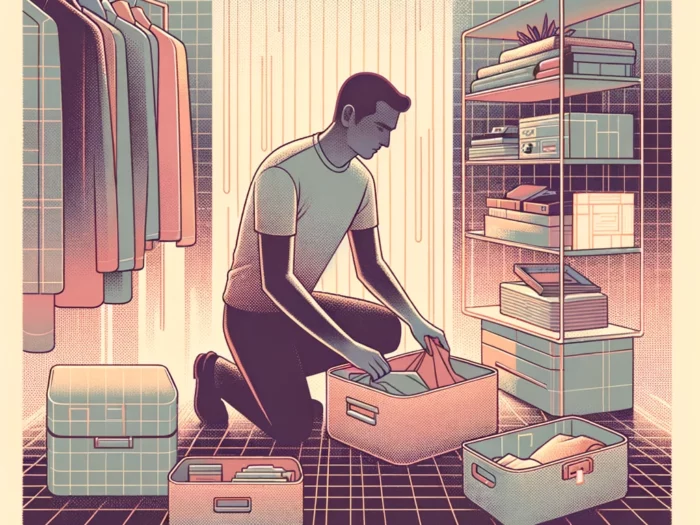In today’s digital age, music is more accessible than ever before. With just a click, we can stream millions of songs from various genres, artists, and eras. But does this abundance of choices enhance our listening experience or overwhelm us? The paradox of choice in the music world often leads to a cluttered library, filled with songs we rarely listen to, and playlists that lack personal resonance.
The concept of simplifying your music collection is not about restricting your musical exploration but rather about curating a collection that truly reflects your tastes, moods, and preferences. It’s about embracing the joy of full albums, the art of intentional playlist creation, and the satisfaction of a well-organized music library.
In this guide, we will explore the shift from music ownership to streaming, the value of listening to complete albums, and practical steps to declutter both your digital and physical music collections. Whether you’re a casual listener or a devoted audiophile, this article aims to help you rediscover the essence of music by focusing on quality over quantity. Join us on this journey towards a more intentional and fulfilling music experience.
The Shift from Ownership to Streaming
The way we consume music has undergone a radical transformation over the past couple of decades. Gone are the days when owning a physical copy of an album – be it a vinyl record, cassette, or CD – was the primary means of enjoying our favorite tunes. Today, streaming platforms like Spotify, Apple Music, and Tidal dominate the music landscape, offering instant access to vast libraries of songs without the need for physical storage.
The Rise of Streaming Platforms
The early 2000s marked the beginning of the digital music revolution. Platforms like iTunes allowed users to purchase and download individual songs, freeing them from buying entire albums for just one or two desired tracks. However, it was the advent of streaming services that truly changed the game. For a monthly fee, these platforms offer unlimited access to their extensive music libraries, curated playlists, and even podcast content. The convenience of having a world of music at our fingertips, without the need to download or store files, has made streaming the preferred choice for many.
Pros and Cons of Streaming vs. Owning
While streaming offers undeniable benefits, it’s essential to weigh them against the advantages of owning music:
Pros of Streaming:
- Vast Selection: Access to millions of songs across various genres and eras.
- Discoverability: Algorithms and curated playlists introduce listeners to new artists and tracks.
- Portability: Listen on any device without the need for transferring files.
Pros of Owning Music:
- Personal Connection: Physical albums, with their artwork and liner notes, offer a tangible connection to the music.
- No Dependency on Internet: Play your music anytime, even in areas without internet connectivity.
- No Monthly Fees: Once you purchase a track or album, it’s yours forever.
However, with streaming, there’s a sense of impermanence. Songs or albums can be removed from platforms due to licensing issues, and if you decide to switch services or if a service shuts down, your curated playlists might be lost.
Finding a Balance
For many, the ideal music consumption method lies in a blend of both worlds. They might stream music for daily listening but purchase albums from artists they truly love, supporting them directly. This hybrid approach allows listeners to enjoy the best of both worlds, combining the convenience of streaming with the personal connection of ownership.
The Joy of Full Albums
In an era of instant gratification and shuffle play, there’s a unique pleasure in immersing oneself in a full album. An album, when crafted thoughtfully, is more than just a collection of songs; it’s a cohesive narrative, a journey crafted by the artist for the listener.
A Dying Art Form?
With streaming platforms promoting singles and algorithm-driven playlists, there’s a growing concern that the art of the album is fading. However, many artists still believe in the power of the album format. They spend years crafting a story, with each track playing a pivotal role in the overarching narrative.
Why Listen to Full Albums?
- Deep Dive into the Artist’s Vision: Albums often provide a deeper understanding of an artist’s thoughts, emotions, and inspirations during a particular phase of their life.
- Experience the Ebb and Flow: Just like a well-written novel, albums have their peaks and troughs, fast tracks followed by ballads, creating a rhythmic flow that’s lost when songs are plucked out and played in isolation.
- Discover Hidden Gems: Singles are often the most commercial tracks on an album, but deep cuts can sometimes be the most rewarding, offering insights and melodies you might otherwise miss.
Rediscovering the Album Experience
To truly appreciate an album, set aside some time, get your favorite headphones, and listen without distractions. Let the music transport you to the world the artist has created. You’ll find that this form of intentional listening can be a deeply enriching experience.
Decluttering Your Digital Music Library
As we embrace the digital age, our music libraries can quickly become cluttered with tracks we’ve long forgotten or rarely listen to. A cluttered library can be overwhelming and detract from the joy of music. Here’s how to simplify and organize your digital collection.
Review and Remove
Start by reviewing your library. Are there tracks or albums you’ve not listened to in years? Songs that no longer resonate with your current tastes? It might be time to let them go.
Organize by Mood or Genre
Instead of a random assortment of tracks, consider organizing your music into playlists based on mood or genre. This not only makes it easier to find the perfect song for any moment but also helps you rediscover tracks you might have overlooked.
Backup Your Collection
While decluttering, ensure you have a backup of your music, especially if they’re tracks you’ve purchased. External hard drives or cloud storage solutions can be invaluable.
Regularly Update Your Library
Set aside time, perhaps once a month, to review and update your library. Add new tracks you love, remove ones you’ve outgrown, and ensure your playlists remain fresh and relevant.
The Joy of a Curated Collection
A well-organized music library enhances your listening experience. It allows for moments of rediscovery, where a long-forgotten track suddenly fits perfectly into your current mood. By decluttering and organizing, you’re not just simplifying your music collection; you’re curating the soundtrack of your life.
The Power of Intentional Playlists
In the age of algorithm-driven recommendations, there’s something deeply personal and rewarding about creating your own playlists. Intentional playlists are more than just a random assortment of songs; they’re a reflection of your emotions, experiences, and memories.
Why Create Intentional Playlists?
- Personalized Experience: Algorithms might suggest songs based on listening habits, but they can’t capture the nuances of your mood or the memories associated with a particular track.
- Thematic Collections: Whether it’s a “Rainy Day” playlist or a collection of songs from your college days, thematic playlists evoke specific emotions and memories.
- Sharing with Others: Playlists can be a way of sharing a part of yourself with friends and family. It’s like creating a mixtape for someone, a gesture that’s both personal and intimate.
Tips for Crafting the Perfect Playlist:
- Start with a Theme: Whether it’s a mood, an event, or a particular memory, having a theme can guide your song selection.
- Variety is Key: Mix different genres, tempos, and artists to keep the playlist engaging.
- Reorder Tracks: The flow of songs is crucial. Ensure there’s a rhythm to your playlist, with tracks complementing each other.
- Review and Refine: Your tastes and moods evolve, and so should your playlists. Regularly update them to keep them fresh and relevant.
Physical Music: The Charm of Tangibility
While digital music offers convenience, there’s an undeniable charm in owning physical music formats. Be it vinyl records, CDs, or even cassettes, the tactile experience of handling and playing physical music adds a layer of intimacy to the listening experience.
Why Physical Music Still Matters:
- Tangible Connection: Holding a vinyl record or CD, admiring the album art, and reading the liner notes create a deeper connection to the music and the artist.
- Sound Quality: Many audiophiles argue that certain physical formats, especially vinyl, offer a warmer and richer sound compared to digital files.
- Nostalgia: For many, physical music formats evoke memories of a different time, adding a layer of nostalgia to the listening experience.
Caring for Your Physical Collection:
- Store Properly: Ensure your records and CDs are stored vertically and away from direct sunlight or heat sources.
- Clean Regularly: Dust and dirt can affect playback quality. Use appropriate cleaning solutions and brushes for maintenance.
- Handle with Care: Always hold records by the edges and CDs by the center hole and edge to prevent scratches.
The Resurgence of Vinyl:
In recent years, vinyl records have seen a resurgence in popularity, with many artists releasing their albums on vinyl. Collecting and playing vinyl offers a unique experience, a blend of nostalgia and high-fidelity sound that many music lovers cherish.
Music and Well-being: The Therapeutic Power of Tunes
Music is more than just a form of entertainment; it’s a powerful tool for healing and well-being. From the rhythmic lullabies sung to babies to the nostalgic tunes that bring comfort to the elderly, music plays a pivotal role in our emotional and mental health.
How Music Affects Our Mood:
- Elevation of Mood: Upbeat and lively songs can elevate mood, making us feel more positive and energetic.
- Relaxation: Slow-tempo music, especially instrumental tracks, can help reduce stress and anxiety, promoting relaxation.
- Emotional Release: Sometimes, a song can resonate with our feelings, allowing us to process and release pent-up emotions.
Music Therapy:
Music therapy is a recognized therapeutic approach where trained professionals use music to address physical, emotional, cognitive, and social needs of individuals. It can be particularly beneficial for:
- Children with Autism: Music can enhance communication and interpersonal skills.
- Dementia Patients: Familiar tunes can evoke memories and reduce agitation.
- Depression and Anxiety: Music can act as a medium for expression and emotional processing.
Creating a Personalized Playlist for Well-being:
Identify songs that resonate with your emotions and create a playlist. It can be a mix of tracks that uplift you, calm you, or even songs that you associate with happy memories. Listening to this playlist during moments of stress or sadness can offer solace and comfort.
Challenges in Maintaining a Simplified Collection
In today’s digital age, where music is more accessible than ever, maintaining a simplified collection can be a daunting task. The constant influx of new releases, personalized music recommendations, and curated playlists can easily lead to an overwhelming collection.
The Allure of New Releases:
Every week, artists from around the world drop new tracks, albums, and EPs. While it’s exciting to discover fresh sounds, it’s essential to discern between genuine interest and the thrill of the new.
Music Recommendations – A Double-Edged Sword:
Streaming platforms, with their advanced algorithms, often suggest tracks based on our listening habits. While this can introduce us to fantastic new artists, it can also lead to a cluttered music library if not approached with intention.
FOMO – The Invisible Pressure:
The Fear of Missing Out, or FOMO, is real. When everyone’s talking about the latest hit or a viral song, the pressure to tune in can be immense. However, it’s crucial to remember that music is a personal journey, and it’s okay to skip the hype sometimes.
Rediscovering Forgotten Gems
Amidst the vast sea of songs, it’s easy to forget those tracks that once resonated deeply with us. These forgotten gems, when revisited, can evoke a wave of nostalgia and emotions.
The Joy of Old Favorites:
There’s a unique warmth in playing a song that’s tied to a memory. Be it the track that played on a first date, a lullaby from childhood, or a tune that got you through tough times – old favorites are like time capsules.
Periodic Reviews – A Trip Down Memory Lane:
Setting aside time to review your music collection can be a therapeutic exercise. Not only does it help declutter, but it also rekindles love for songs that might have been lost in the shuffle. It’s like meeting an old friend – familiar, comforting, and full of stories.
Music, in its essence, is a reflection of our emotions, memories, and experiences. While the vast world of music offers endless exploration opportunities, there’s unparalleled joy in a simplified, intentional collection. It’s not about having less but about having more of what truly resonates. As you navigate your musical journey, remember to cherish the tracks that touch your soul and let go of the noise. Start today, curate with purpose, and embrace the beauty of intentional music listening.









